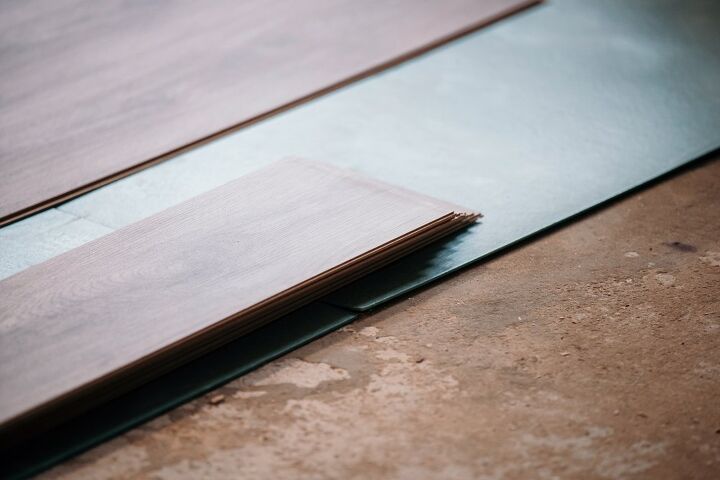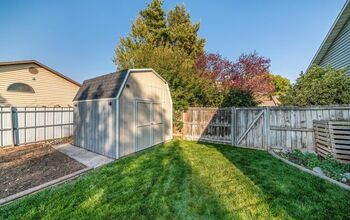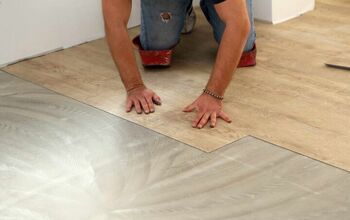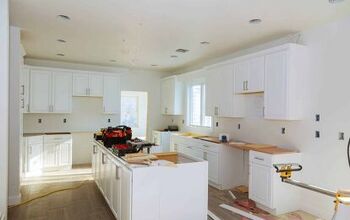Can You Install Vinyl Floor Planking On Uneven Floor?

Vinyl floor planking is a widely popular and cost effective flooring option. At $2-$7 per square foot, vinyl floor planking is a great option for homeowners trying to save money. However, many homeowners wonder if vinyl floor planking can be installed on their uneven floor.
You can only install vinyl planks on uneven flooring if the unevenness is mild. It’s possible to even the floor out if you sand and buff the subfloor before you install vinyl planks. Vinyl is a flexible material and can adhere to surfaces that don’t fall within the 3/16” range per 10 feet “level” range.
Let’s explore the ins and outs of installing vinyl floor planking on an uneven floor.
Do You Need Flooring or Tile Installation?
Get free, zero-commitment quotes from pro contractors near you.

What Is Vinyl Floor Planking?
Vinyl floor planking mimics the appearance of hardwood but as the name suggests, it is made out of vinyl. Typically, vinyl floor planking costs $2-$3 per sq. ft., but can get up to $7 or $8 per sq. ft.
When compared to the wood flooring that vinyl mimics, vinyl is a much better deal. Wood flooring costs $8 or more per sq. ft. on the low end. One of the draws of vinyl over wood is that vinyl floor planking is waterproof.
Not only will vinyl floor planking withstand spills, but it will hold up to humidity and moisture. Vinyl floor planking is not quite as durable as hardwood, but the low cost more than makes up for it.
Does Vinyl Floor Planking Work On Uneven Floors?
The reason that vinyl floor planking is often the choice for uneven floors is because of how flexible it is. However, if your floor is extremely uneven, you’ll want to choose an alternative like laminate sheets.
Because vinyl floor planking comes in strips and planks, it can easily be laid out on uneven floors. Vinyl itself is a very malleable and an easy to work with material.
Flooring is considered “level” if it is within the 3/16” range per 10 feet. There are no specific measurements deemed “uneven”, but if your floor is not within that range, it is uneven.
Is Vinyl Flooring Flexible?
If you were to put say, hardwood on an uneven floor, you wouldn’t get the flexibility of vinyl. In fact, using hardwood on an uneven floor is not advisable. That is, unless you do a lot of prep work by resurfacing the floor before installing the wood.
Essentially, vinyl flooring easily conforms to the subfloor that it is being installed over. Because of that, installing vinyl floor planking on slightly uneven surfaces is easy and it holds well.
Do You Need To Prepare Subfloor For Vinyl Floor Planking?
Yes, you will need to clean the subfloor and try your best to fill cracks using a floor patching product like SimplePrep. If there is residue or adhesive from old carpet or previous flooring, scrape it off and sweep the subfloor.
Since your floor is already uneven, you want to minimize any other possible inconsistencies in the subfloor. You can actually make the floor more level with a little bit of prep work.
All that you need to do to make your floor more even is use a belt sander to sand down the higher peaks in the subfloor. With that said, sanding it down won’t be necessary if your floor is only barely uneven if you are using vinyl floor planking.
Be careful and remember that you should only sand the subfloor, not the vinyl planking itself. Sweeping any debris off of the subfloor surface is important so that your planks will lay well.
How To Install Vinyl Floor Planking On An Uneven Floor
After you have prepared your uneven subfloor, you can begin the process of installing your vinyl floor planking. Before you do anything, measure the floor.
It is generally recommended that you buy an extra 20-30% more vinyl planks than you actually need. That is because that way, you won’t be left in the lurch if you damage any of the planks or need more than expected.
Tools You Will Need
- Utility knife
- Measuring tape
- Chalk (for marking)
- A straight edge
- Jig saw
The utility knife will come in handy when you score the planks. A straight edge is a must because you want to make sure that your planks run even to one another. The measuring tape and chalk will help you mark where the planks will go.
You will need a jig saw to cut the planks to your measurements. Luckily, cutting vinyl is easier than cutting hardwood.
1. Prepare For Installation
After you have swept the subfloor and gotten it smooth, remove the baseboards. Once you’ve removed the baseboards, you can measure the floor. After measuring the floor, plan out how you want the planks to lay. This is where you can get creative.
2. Cut The Planks
Cut your planks to no more than half of the width that you purchased them. If the width was 8”, don’t cut the plank any smaller than 4”. Using a jigsaw is the easiest way to cut vinyl planks.
3. Place The Planks
Now you can place the planks. Start by placing the first row against the longest wall. Feel free to experiment with the patterns of the planks.
Use your utility knife to cut the “tongue” off of the plank so that it will sit along the wall and other planks.
Usually, vinyl plank flooring has a variety of patterns, so you can arrange the planks in order to achieve a unique pattern.
Arrange the plank placement by going short end/long end/short end/long end so that the “joints” are alternated.
4. Place The Rest Of The Planks
Continue the staggering of the planks so that the joints alternate until you are out of planks. Now, you can reattach your baseboards. If you have trim, you can install it by nailing it to the wall and laying it over the end of the plank.
How To Maintain Your Vinyl Plank Flooring
One of the best things about vinyl plank flooring is how low maintenance they are. Unlike wood floors, cleaning vinyl plank flooring using water won’t cause damage.
The water resistance of vinyl flooring means that you can mop it easily. Whether you need to use a mop and water, wax, or a vacuum, you won’t need to worry about damaging your vinyl flooring.
Do You Need Flooring or Tile Installation?
Get free, zero-commitment quotes from pro contractors near you.

What Did We Learn?
A level floor is one that measures within the 3/16” range per 10 feet. If your floor is uneven and not within that range, vinyl floor planking is a great option.
That is because vinyl floor planking is highly flexible and lays well over uneven surfaces. If your floor is wildly uneven, consider using a sander to even the subfloor out.
As long as you fill the cracks, sweep the debris, and remove any old carpet or planks, you can easily install vinyl floor planking on uneven floors.
Not only that, but you can do it cheaply. At roughly $2-$3 per sq. ft., vinyl floor planking is your best and cheapest option for uneven floors. It is easy to install, cost effective, water resistant, and perfect for uneven floors.

Nick Durante is a professional writer with a primary focus on home improvement. When he is not writing about home improvement or taking on projects around the house, he likes to read and create art. He is always looking towards the newest trends in home improvement.
More by Nick Durante













![Finishing Basement Without Permit [Is It Really Illegal?]](https://cdn-fastly.upgradedhome.com/media/2023/07/31/9070078/finishing-basement-without-permit-is-it-really-illegal.jpg?size=350x220)







![How To Reset A Whirlpool Cabrio Washer [In 5 Easy Steps!]](https://cdn-fastly.upgradedhome.com/media/2023/07/31/9076531/how-to-reset-a-whirlpool-cabrio-washer-in-5-easy-steps.jpg?size=350x220)





